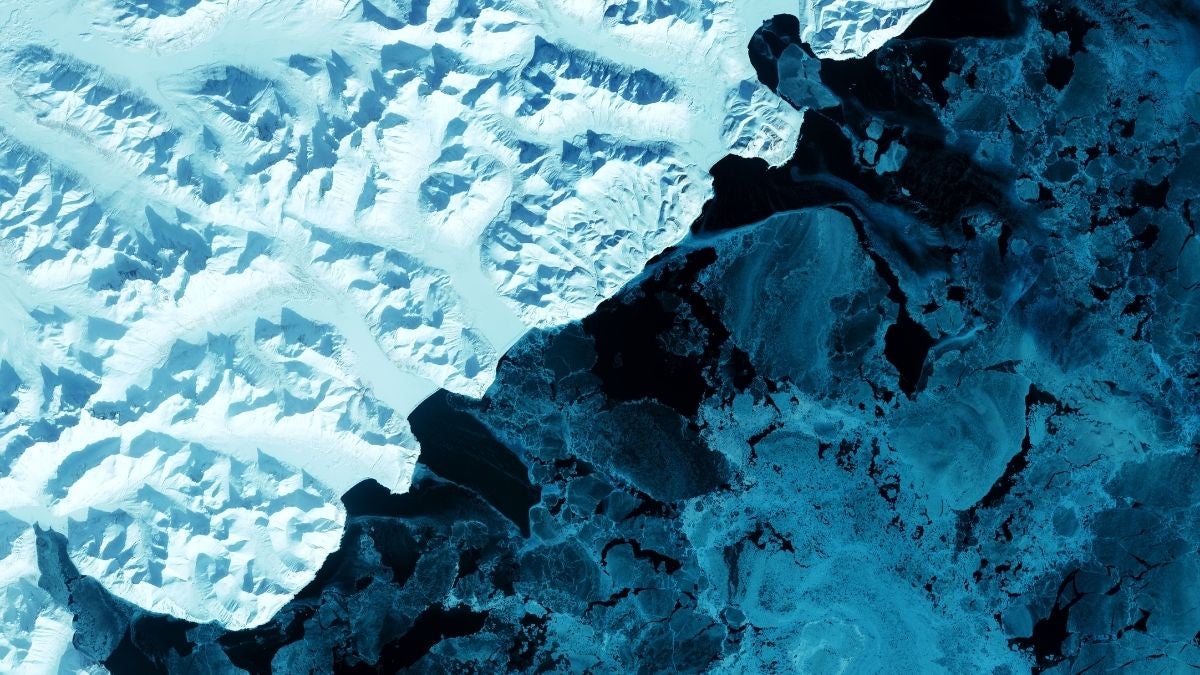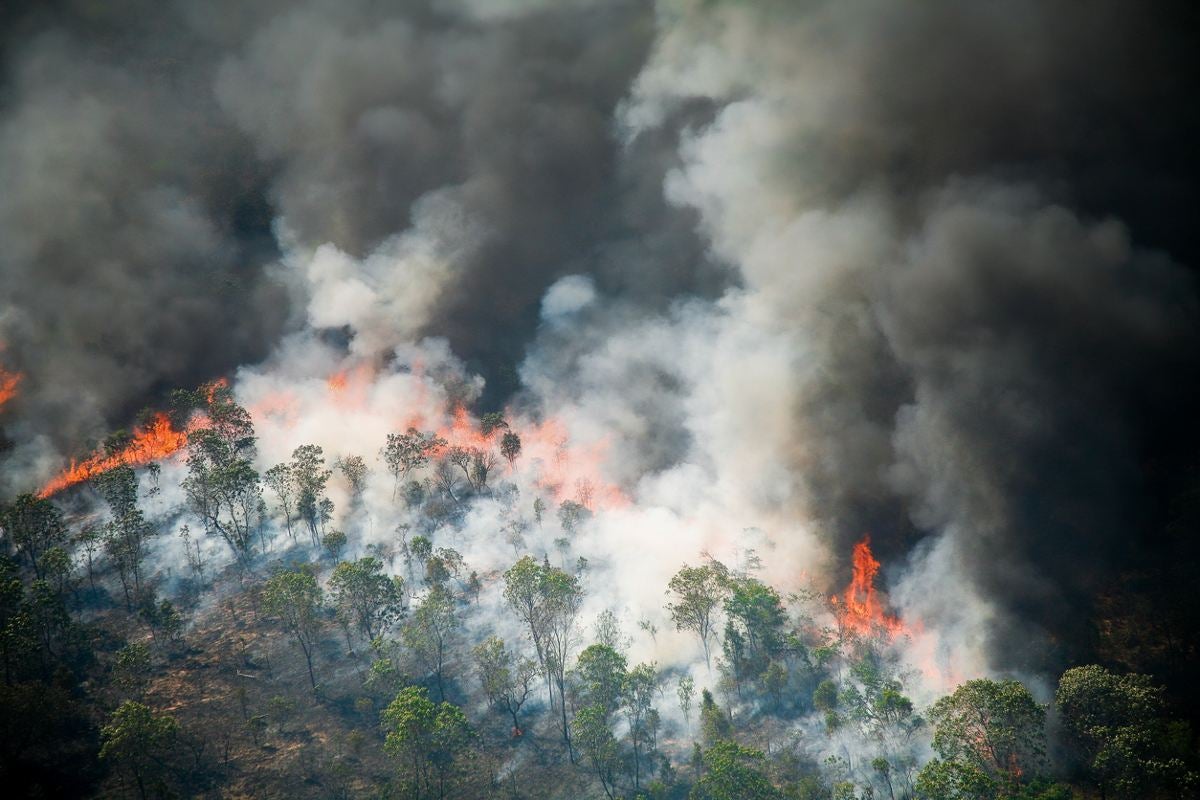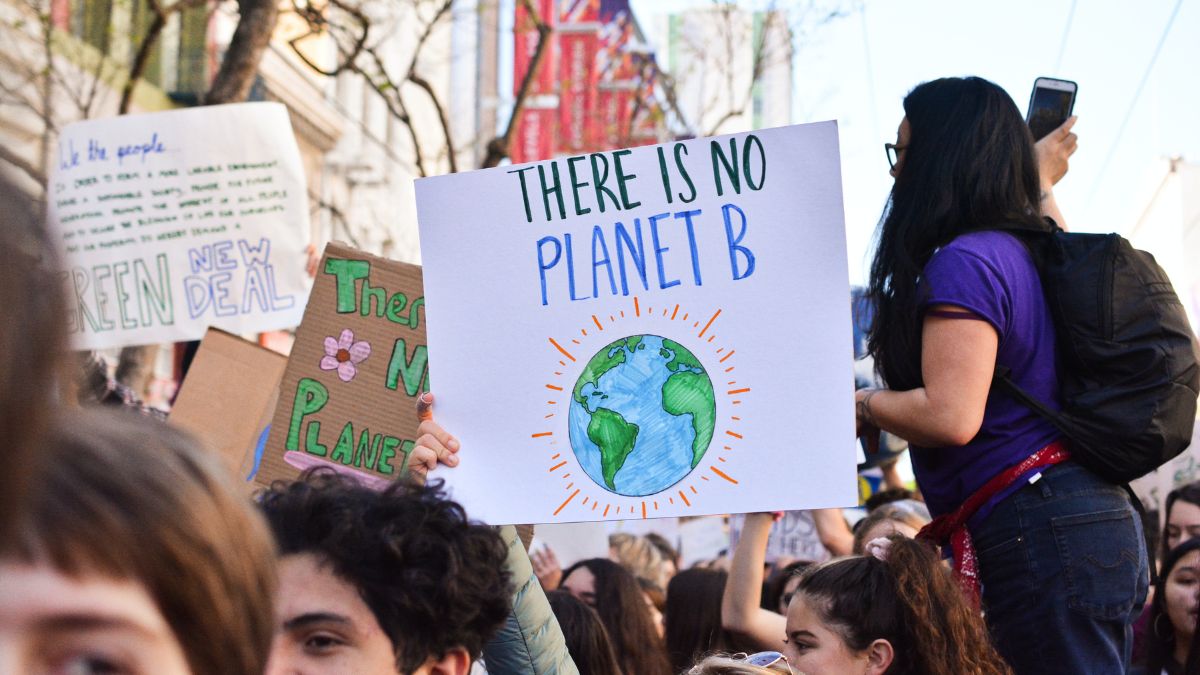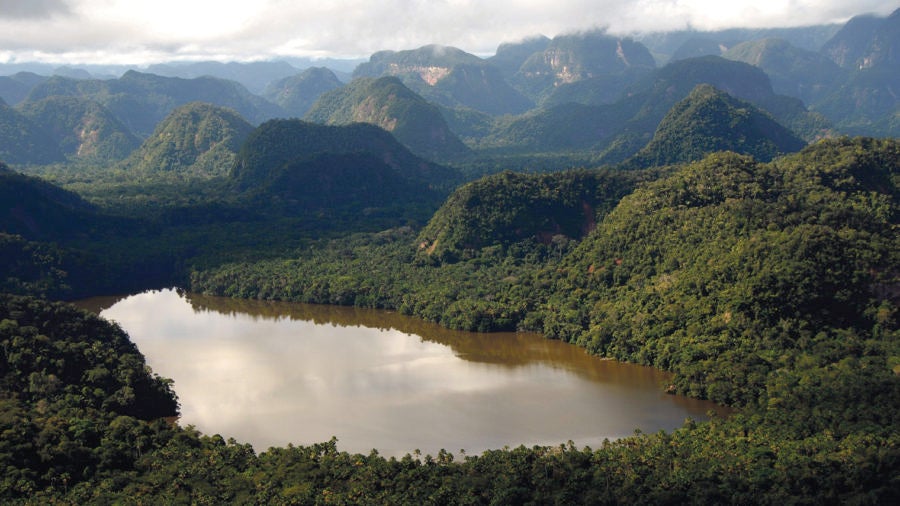
For outsiders trying to follow proceedings at the annual Conference of the Parties (COP) to the United Nations Framework Convention on Climate Change, the sheer volume of jargon used at this event can be a barrier. Experts in this fast-evolving field have coined hundreds of technical terms over the decades.
Some, such as climate reparations, are relatively new, but older phrases are still often misunderstood. Several more – leakage, for instance – mean something entirely different from their ordinary definition.
This year, another jargon-heavy sector will share the spotlight: finance. COP 29 has been dubbed the “finance COP” and a major ambition will be adopting a new climate finance target. The previous financial goal – that richer nations would provide $100bn a year to support developing nations – was agreed 15 years ago. This year’s conference, in Azerbaijan, will focus on reevaluating this number and has already resulted in a flurry of new terms, including the new collective quantified goal (NCQG).
The following glossary explains this, and many other, key climate-related terms that scientists and policy-makers commonly use, so that everyone can understand them.
Adaptation
This is the process of making changes to protect communities against the impacts of extreme and less predictable weather that’s already resulting from global warming. It can include measures such as taking out climate insurance; altering what crops are grown in an area; and building infrastructure such as flood defences.
Mitigation
This refers to efforts to lower the volume of greenhouse gas in the atmosphere. It can involve either reducing emissions – such as by using less fossil fuel and switching to renewable energy sources – or enhancing sinks that can remove gases from the air, including forests or artificial carbon-capture systems.
Climate finance
This refers to money set aside to fund mitigation and adaptation projects around the world. These rarely come cheap, of course. Even wealthy countries will struggle to fund such measures, let alone the many emerging economies that are already experiencing the most extreme weather.
According to the Organisation for Economic Co-operation and Development, rich countries committed $83.3bn in 2020 to help poorer nations deal with the “loss and damage” they had experienced (breaking an earlier pledge to provide £100bn a year by that point). Denmark was the first country to pledge specific compensation to countries most affected by climate change.

Climate glossary
1.5 degrees
A 1.5C limit on the rise in the Earth’s average temperature above pre-industrial levels was enshrined in the UN’s 2015 Paris agreement. Projections from its Intergovernmental Panel on Climate Change (IPCC) suggest that increases above this level would cause some of the worst effects of climate change to become commonplace, putting billions of people at risk and causing irreversible environmental damage. Research indicates that the planet has already warmed by 1.1C, according to the IPCC.
Afforestation and reforestation
Reforestation means returning land that was previously tree-covered back to its original state. Afforestation is the creation of new woodland. Both are widely regarded as powerful mitigation measures.
Anthropocene
The geological history of the Earth is divided into epochs. The current epoch, the Holocene, began roughly 11,500 years ago at the end of an ice age. Some scientists have started suggesting that humans have made such enormous changes to the planet over the past 60 years that it has entered a new epoch: the Anthropocene.
Biodiversity
The variety of life on Earth, covering species ranging from a bacterium all the way up to a blue whale. This is in steep decline in several territories. The UK, for instance, has lost about half of its biodiversity in the modern era, making it one of the most nature-depleted countries.
Biofuel
A fuel made from organic matter over a short time span (as opposed to the long-term processes that create fossil fuels such as coal and gas). Biofuel includes wood as well as bioethanol and biodiesel made from crops, waste oil and algae. Many emit relatively few net greenhouse gases when burnt, but they can have other negative environmental impacts.
Carbon border adjustment mechanism (CBAM)
The CBAM is an import tax on carbon-intensive products such as steel, aluminium, cement and fertiliser. It’s part of the EU’s strategy to cut its greenhouse gas emissions by at least 55% by 2030. The system is designed to level the playing field for EU-based companies, helping them to remain competitive with firms from jurisdictions that might not operate to such strict targets.
Carbon capture and storage
The process of capturing, transporting and storing carbon dioxide from a large emitting source, such as a power plant or industrial facility, before it enters the atmosphere. The storage process, sometimes referred to as sequestration, often involves injecting the CO2 deep underground.
Carbon capture and utilisation
A process of collecting carbon dioxide from one source and reusing it to produce a new product. Although this process doesn’t remove carbon from the atmosphere, recycling the CO2 can turn a carbon-intensive process into a carbon-neutral one.
Carbon credits
Carbon credits can be earned through offsetting, with each certified credit representing an emissions reduction equivalent to one tonne of carbon dioxide. These credits can then be purchased by a company or country to count towards its own carbon-reduction goals.
Carbon dioxide equivalent (CO2e)
A measurement used to group greenhouse gases based on their warming potential. Using this measurement helps to account for the emissions of all gases that contribute to the heating of the planet, such as methane and nitrous oxide, by calculating the amount of carbon dioxide that would cause the same amount of warming.
Carbon footprint
A carbon footprint can refer to the amount of carbon emitted by a company over a given period, the lifetime of a product or an individual’s actions – travelling by air, for instance.
Carbon insetting
While carbon offsetting often relies on a third party to cancel out previously emitted CO2, carbon insetting brings the carbon removal process in-house. It refers to carbon reduction projects that companies conduct within their own supply chains.
Carbon intensity
The amount of carbon dioxide emitted per unit of electricity generated. Cleaner fuels have a lower carbon intensity. The term can also refer to the level of emissions a country or company produces relative to its economic output.
Carbon neutral
Becoming carbon neutral can be achieved by removing or eliminating the same amount of greenhouse gas emitted into the atmosphere. This is also sometimes referred to as being net zero.
Carbon offsetting
This refers to an organisation’s attempt to compensate for its carbon dioxide emissions by funding efforts to remove the equivalent amount from the atmosphere elsewhere. This often involves a third party, which is paid to perform the decarbonising action in return for carbon credits. Common carbon offsets include planting trees or funding projects to generate renewable energy. It is often used in areas of the economy that are hard to decarbonise, such as air travel.
Carbon sequestration
The process of capturing and storing carbon dioxide from the atmosphere and storing it in a solid or liquid form (see carbon capture and storage). It is a method of reducing or reversing the impact of CO2 pollution and mitigating the effects of climate change.
Certified emission reductions (CERs)
These are carbon credits issued by the UN to countries for projects that mitigate greenhouse gas emissions. Countries can trade CERs to help them meet their emission reduction goals. For example, China could buy credits earned by a reforestation project in Kenya and use these to offset its own emissions.
Citizens’ assembly
A representative group of lay people who gather to discuss government policy in a particular area and recommend new measures. They have been used in Ireland and Spain to address climate change and are widely promoted by groups such as Extinction Rebellion as a way to reach a consensus on solutions.
Climate justice
Climate justice is the recognition that climate change will not affect everyone equally. People who are young, poor, marginalised and living in developing countries are among those least responsible for the world’s greenhouse gas emissions, yet they will tend to feel the worst effects of global warming and climate change.

Climate positive
Climate positive status is an improvement on net zero, in that the amount of carbon dioxide an entity is removing from the atmosphere exceeds what it’s emitting.
Climate reparations
This is a key demand of the climate justice movement. Many argue that developed countries should pay nations in the Global South to help them prepare for the worst consequences of climate change.
Climate tech
This term refers to advanced technologies that are being designed and developed to help decarbonise the global economy. It’s often applied to startups in the field.
COP29
The 29th annual Conference of the Parties to the United Nations Framework Convention on Climate Change will be held on 11 November to 22 November 2024. Climate experts, campaigners and policymakers from nearly 200 countries will convene in Baku, the capital city of Azerbaijan, to discuss how best to avert the worst effects of climate change.
Corporate sustainability reporting directive (CSRD)
The EU’s corporate sustainability reporting directive (CSRD) increase the sustainability reporting requirements for all large and listed companies. Under the new rules, companies will have to report on both their impacts on people and the environment, and on how social and environmental issues create financial risks and opportunities for the business. The new obligation is set to apply to more than 50,000 companies, including some British firms operating in the single market.
Emissions trading scheme (ETS)
Also known as cap and trade, an emissions trading scheme sets a limit on the maximum amount of emissions and issues permits that companies can buy or trade. This creates a carbon market with the aim of encouraging firms to reduce their emissions. The EU ETS is the world’s largest, while the UK has operated its own scheme since January 2021.
Energy charter treaty (ECT)
An international treaty signed in 1991 to promote collaboration among countries with a large stake in the energy industry, especially the fossil fuels sector. Because it allows investors to sue for lost profits owing to government policy changes, it has come under fire for obstructing national efforts to combat climate change. Several European countries – most recently, France – have declared their intention to pull out of the agreement.
Energy transition
The global effort to move from fossil fuels and other non-renewables to cleaner sources of energy, such as wind, solar and green hydrogen.
Global goal on adaptation (GGA)
Established in article seven of the Paris agreement, the GGA is focused on helping countries adapt, develop resilience and become less vulnerable to the effects of climate change. At COP28 last year, the parties adopted a framework for the GGA and established targets to hit by 2030. At COP29, the focus is on agreeing on the right indicators to track progress towards these targets.
Global stocktake
The first ever global stocktake took place at COP28 and is used as a chance to assess the progress that has so far been made towards the goals of the Paris agreement. More than 1,000 documents were submitted by governments, scientists and civil society organisations to inform the stocktake. Its conclusions can inform us how successful global climate actions have been so far and where there is room for improvement.
Greenwashing
This is the pejorative term applied to a marketing campaign that’s designed to draw attention to an entity’s sustainable practices and, often, distract from its more environmentally damaging behaviour.
Greenhouse gases
These are compounds that contribute to global warming through the greenhouse effect when they are emitted into the atmosphere. The Kyoto protocol concerns the emission of carbon dioxide, methane, nitrous oxide, sulphur hexafluoride and members of both the hydrofluorocarbon and perfluorocarbon groups.
Intergovernmental Panel on Climate Change
The IPCC is the UN’s body for providing scientific assessments of climate change. It was created to give policy-makers regular updates on the implications and potential future risks of climate change and to suggest possible adaptation and mitigation measures. The panel’s most recent report was described as a “code red for humanity” by the UN’s secretary-general, António Guterres.
Just transition
Many organisations agree that it’s important for the energy transition to happen in a way that is socioeconomically fair. For instance, coal miners left out of a job should be supported to retrain and find new work. The EU has allocated €150m (£131m) to its just transition fund.
Kyoto protocol
Signed at COP3 in 1997, the Kyoto protocol was an international treaty committing all signatories to reduce the world’s greenhouse gas emissions. Coming into force in 2005, it was the first pact of its kind to set national governments legally binding targets. It was superseded by the Paris agreement in 2015.
Leakage
While it sounds like it refers to gas or oil escaping a pipeline, leakage has a specific meaning in environmental terms. It happens when one country’s climate policies result in higher greenhouse gas emissions in another. For example, many western countries have reduced their carbon footprints by moving polluting industries abroad.
Loss and damage
The negative effects experienced as a result of climate change. It has been claimed that some countries have already lost a fifth of their wealth as a result of extreme weather, for example.
Nationally determined contributions (NDCs)
The NDCs are the commitments countries have made in their efforts to tackle climate change, including reducing their greenhouse gas emissions. The Paris agreement requires each of the parties to “prepare, communicate and maintain” NDCs and these must be updated every five years. Brazil, the UK and the UAE are all set to announce new NDCs in 2024.
Natural capital
A way to describe the wealth a country holds in terms of natural resources such as fertile soil, fresh water, clean air and biodiverse habitat. It has been argued that this should be measured, like GDP or financial assets, to encourage governments to conserve nature.
Net zero
Net zero refers to the point at which the amount of greenhouse gas being emitted into the atmosphere equates to the amount being removed.
New collective quantified goal (NCQG)
At COP29, participants will work to replace the previous $100bn climate finance target – the NCQG – set in 2009. The money contributed by countries under the NCQG will go towards helping developing nations adopt lower-carbon energy and infrastructure and build resilience to the impacts of climate change. No alternative figure has been put forward yet, but it is likely to be much higher than the previous $100bn, perhaps even into the trillions of dollars.
Ocean acidification
A side effect of climate change, in which the increasing absorption of carbon dioxide by the world’s oceans is lowering their pH. In other words, they have become about 30% more acidic than they were in the pre-industrial era. This has damaged a wide range of marine ecosystems.
Paris agreement
A legally binding international treaty that was signed during COP21 in 2015. It set important goals to keep the rise in global temperatures below 2C and aim for less than 1.5C. It also set financial targets for developed nations to help mitigate the impacts of climate change.
Paris agreement crediting mechanism (PACM)
PACM is the United Nations’ carbon crediting mechanism. It provides a way for companies in different countries to work together on reducing their emissions. Through the PACM, should one company manage to reduce emissions in one country, it can earn credits which it can sell to another company in another country, to help them meet their own emission-reduction targets.
Rewilding
Returning ecosystems to their natural state without human intervention. It’s often achieved by reintroducing native species to an area, stopping wildlife culls and allowing forests to regenerate on their own instead of planting trees.
“Nature knows best when it comes to survival and self-governance,” argues the charity Rewilding Europe. “We should step back and let nature manage itself.”

Scope one emissions
Scope one concerns the greenhouse gases emitted directly by an entity, such as those released as a result of a business’s industrial operations.
Scope two
Scope two covers an entity’s indirect emissions, often associated with the production of gas and electricity it purchases from an energy supplier.
Scope three
Scope three covers all emissions up and down the entity’s value chain. For many businesses, this is the source of most of their emissions. Upstream emissions include those arising from the production of materials purchased by the company, such as packaging; the distribution of finished goods; and business travel by employees. Downstream emissions include those generated by the use of its products and their end-of-life treatment, as well as those of any leased assets, franchises or investments.
Sink
Anything that absorbs more carbon dioxide than it emits, including the sea, soil and vegetation. In the future, it may be possible to create artificial sinks through the use of carbon capture and storage technology.
Tipping point
In climate science, this is the situation in which irreversible changes will happen and become self-perpetuating. Examples include the collapse of the east Antarctic ice sheet and the loss of tropical coral reefs.
UAE consensus
This is the set of goals agreed upon by the 198 parties at COP28 in Dubai in 2023. Key elements include the transition away from using fossil fuels in energy systems and calls to triple renewable energy, halt deforestation and scale adaptation finance.
United Nations Framework Convention on Climate Change (UNFCCC)
This was a landmark international treaty signed at the Earth summit in Rio de Janeiro in 1992. It serves as the parent treaty to both the Kyoto protocol and the Paris agreement. The UNFCCC is also the name of the secretariat that supports the treaty’s operation. It is based in Bonn, Germany.
Warsaw international mechanism for loss and damage
Established at COP19 in 2013, this framework promotes dialogue and research to address the effects of climate change. It contains no provision for countries to pay climate reparations.

For outsiders trying to follow proceedings at the annual Conference of the Parties (COP) to the United Nations Framework Convention on Climate Change, the sheer volume of jargon used at this event can be a barrier. Experts in this fast-evolving field have coined hundreds of technical terms over the decades.
Some, such as climate reparations, are relatively new, but older phrases are still often misunderstood. Several more – leakage, for instance – mean something entirely different from their ordinary definition.
This year, another jargon-heavy sector will share the spotlight: finance. COP 29 has been dubbed the “finance COP” and a major ambition will be adopting a new climate finance target. The previous financial goal – that richer nations would provide $100bn a year to support developing nations – was agreed 15 years ago. This year’s conference, in Azerbaijan, will focus on reevaluating this number and has already resulted in a flurry of new terms, including the new collective quantified goal (NCQG).
